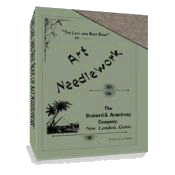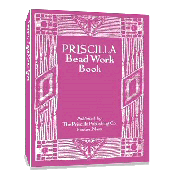How to Wash Embroidered Linens
This article about how to wash embroidered linens was published in Corticelli’s Home Needlework magazine, 1898. It was written by L. Barton Wilson, a highly known needlecrafter at that time. Some of tips are still applicable but, thankfully, others are not. Do you really want to paste on the wrong side of your embroidery? That was what Victorian women were told. Read it for yourself!
To Wash Embroidered Linens
Edited for use on this site.
Avoid all risk of rust or stain by using an earthen wash bowl in preference to a tin or wooden tub. Wash by dipping in suds as hot as the hand can comfortably bear, made with "Ivory" or any other pure soap.
If there are any spots on the article wash them out first, before wetting the entire piece. Beyond this do not rub or fold, but plunge the linen up and down in the suds. If it is very much soiled or yellow, a half teaspoonful of borax may be added without the least danger to the silk. Carefully avoid washing powders and cheap soaps.
When clean, rinse by plunging up and down in several tepid waters or until the water remains perfectly clear. If the soap is not entirely removed by rinsing, the linen will yellow quickly.
Dry partially by laying between two soft cloths or towels for a few minutes, A new and very successful method for drying and pressing, especially small sized linens, is as follows:
Lay them close and smooth on a marble slab or board. The woof and warp should be drawn perfectly straight and the stitches of the embroidery should be brought into position — that is, so they will lie as placed when worked.
To dry a large article, place a sheet on the carpet and pin the piece through it to the carpet straight by the edges, stretching a little. The drying may be hastened by fanning or by holding a hot iron within half an inch of the surface.
Doilies pinned to a board or frame may be dried in a minute by holding them in front of a register, and thus treated they should need no pressing with an iron.
Larger linens may be placed on a fine sheet, face downward, and "touched up" with a moderately hot iron; the marks of the pins may be removed by dampening and pressing. Imperfections in the linen's smoothness may be dampened but the silk should not be wet.
The hem will likely need firm pressing; fringe should be brushed and lightly combed out; it will then likely need a little trimming.
All Corticelli Silk will remain fast in color if these directions for washing are followed, and the laundered embroidery will appear no different from that just finished. The peculiar luster, or bloom, of this beautiful silk will be retained if the new method of quick drying, under tension, is carried out.
To set embroidery for the first time, dampen the linen and silk on the wrong side and dry quickly before removing from the hoop. In all cases of fabrics that are not washable set embroidery by pasting on the reverse side.
After spending so much time making the perfect embroidered piece, it will pay you great dividends to know how to correctly wash embroidered linens with care! Always be sure to read the care directions for the fabric and embroidery supplies you use. Following the manufacturer's suggestion is the best way to be sure your finished project stays beautiful for years to come.
Return to top of How to Wash Embroidered Linens page.
Return to Hand Embroidery page.
The Last and Best Book of Art Needlework
Over 100 pages of authentic Victorian instructions and patterns from 1895!
FREE
Beeton's Book Of Needlework

433 pages!
Sign up for VEAC! Everything you wanted to know about Victorian embroidery, needlework, crafts and more!
Priscilla Bead Work Book
Make Beautiful Victorian Beaded Purses, Jewelry & Accessories - Starting
TODAY!


